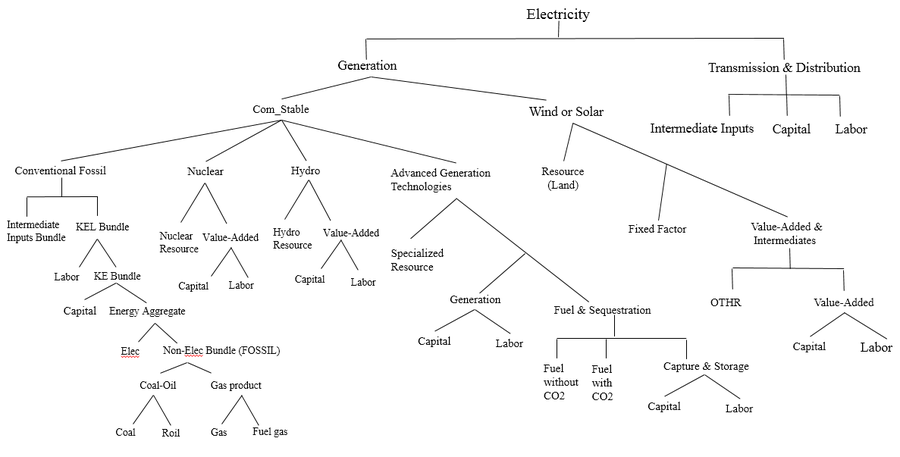Electricity - C3IAM: Difference between revisions
No edit summary |
No edit summary |
||
| Line 7: | Line 7: | ||
[[File:6.png|left|900px|thumb|Figure 1. The production structure of the electricity sector in C<sup>3</sup>IAM.|left]] | [[File:6.png|left|900px|thumb|Figure 1. The production structure of the electricity sector in C<sup>3</sup>IAM.|left]] | ||
<br><br><br><br><br><br><br><br><br><br><br><br><br><br><br><br><br><br><br><br> | <br><br><br><br><br><br><br><br><br><br><br><br><br><br><br><br><br><br><br><br><br><br><br><br><br><br><br> | ||
Most of these advanced technologies have emerged as perfect substitutes for existing technologies. The only exception is wind and solar technology, which goes to the very top of the nest, and substitutes for other electricity technologies. Treating them as imperfect substitutes represents the uniqueness of these renewable technologies. While they can be well suited to some remote locations, they also suffer from intermittency that can increase their cost if they were to provide a large share of electricity production. Alternative substitute parameter allows gradual penetration only if the prices of other generation technologies continue to rise, and tends to limit the share of electricity that can be generated by wind and solar. | Most of these advanced technologies have emerged as perfect substitutes for existing technologies. The only exception is wind and solar technology, which goes to the very top of the nest, and substitutes for other electricity technologies. Treating them as imperfect substitutes represents the uniqueness of these renewable technologies. While they can be well suited to some remote locations, they also suffer from intermittency that can increase their cost if they were to provide a large share of electricity production. Alternative substitute parameter allows gradual penetration only if the prices of other generation technologies continue to rise, and tends to limit the share of electricity that can be generated by wind and solar. | ||
Latest revision as of 13:03, 5 August 2021
| Corresponding documentation | |
|---|---|
| Previous versions | |
| Model information | |
| Model link | |
| Institution | Center for Energy and Environmental Policy Research, Beijing Institute of Technology (CEEP-BIT), China, http://ceep.bit.edu.cn/english/. |
| Solution concept | General equilibrium (closed economy) |
| Solution method | Optimization |
| Anticipation | |
The production structure for electricity sector is the most detailed among the sectors (Figure 1), which allows substitution of different generation technologies. These include generation technologies that exist in the base year data (conventional fossil energy, nuclear, and hydro) and advanced technologies that did not exist in the base year data.
Most of these advanced technologies have emerged as perfect substitutes for existing technologies. The only exception is wind and solar technology, which goes to the very top of the nest, and substitutes for other electricity technologies. Treating them as imperfect substitutes represents the uniqueness of these renewable technologies. While they can be well suited to some remote locations, they also suffer from intermittency that can increase their cost if they were to provide a large share of electricity production. Alternative substitute parameter allows gradual penetration only if the prices of other generation technologies continue to rise, and tends to limit the share of electricity that can be generated by wind and solar.
The lower nests in Figure 1 represent the structure within particular generation technologies. However, conventional fossil fuels do not separately represent coal, oil, and gas generation technologies, but instead deal with these technologies through direct substitution among the fuels.
Nuclear and hydro are with much simpler structures, concentrating on related resources, capital and labor. In both cases, resources are represented as fixed factor endowments that are specific to technology and region. Over time, changes in resources are externally controlled.
The two advanced fossil electricity generation technologies have similar structures. These technologies represent a natural gas combined cycle technology with carbon capture and sequestration (NGCC-CCS), and an integrated coal gasification technology with carbon capture and sequestration (IGCC-CCS). The elaborated production structures for these technologies also include energy and capital penalty for capture and sequestration.
